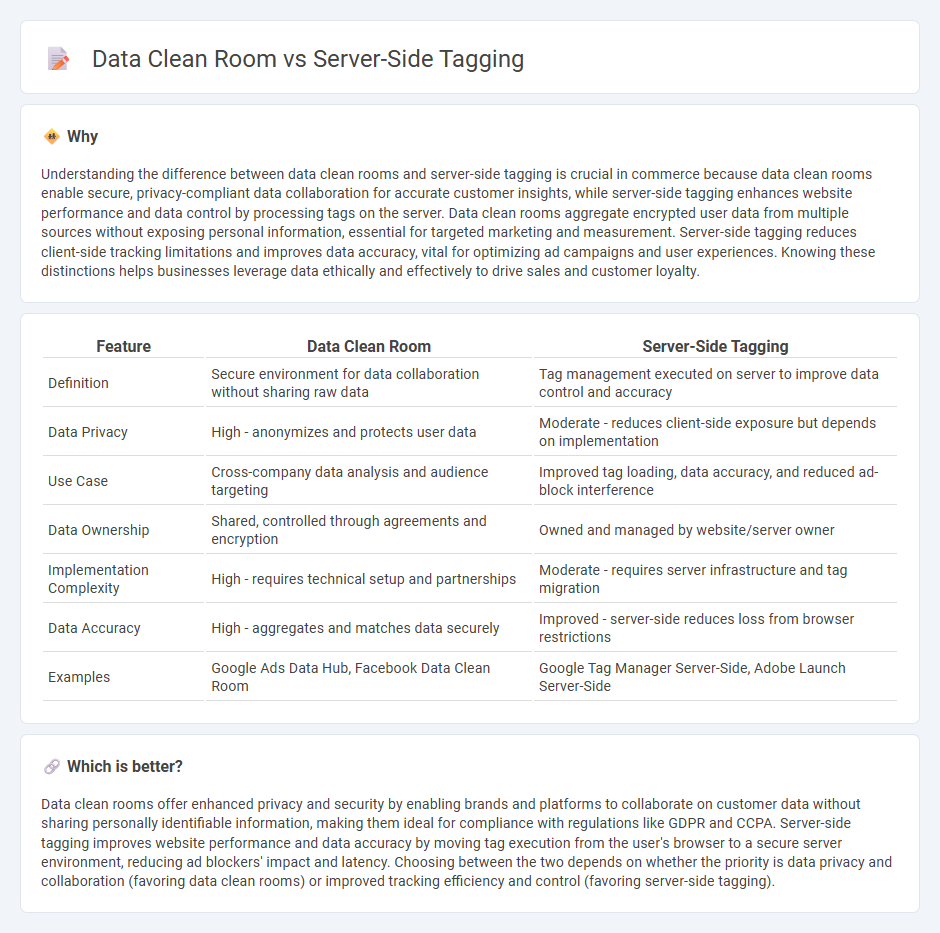
Data clean rooms enable secure data collaboration by allowing multiple parties to analyze combined datasets without exposing raw customer information, enhancing privacy and compliance in commerce. Server-side tagging improves website performance and data accuracy by moving tag execution from browsers to servers, reducing tracking errors and ad blockers' impact. Explore how these technologies transform data-driven marketing strategies and optimize ecommerce performance.
Why it is important
Understanding the difference between data clean rooms and server-side tagging is crucial in commerce because data clean rooms enable secure, privacy-compliant data collaboration for accurate customer insights, while server-side tagging enhances website performance and data control by processing tags on the server. Data clean rooms aggregate encrypted user data from multiple sources without exposing personal information, essential for targeted marketing and measurement. Server-side tagging reduces client-side tracking limitations and improves data accuracy, vital for optimizing ad campaigns and user experiences. Knowing these distinctions helps businesses leverage data ethically and effectively to drive sales and customer loyalty.
Comparison Table
| Feature | Data Clean Room | Server-Side Tagging |
|---|---|---|
| Definition | Secure environment for data collaboration without sharing raw data | Tag management executed on server to improve data control and accuracy |
| Data Privacy | High - anonymizes and protects user data | Moderate - reduces client-side exposure but depends on implementation |
| Use Case | Cross-company data analysis and audience targeting | Improved tag loading, data accuracy, and reduced ad-block interference |
| Data Ownership | Shared, controlled through agreements and encryption | Owned and managed by website/server owner |
| Implementation Complexity | High - requires technical setup and partnerships | Moderate - requires server infrastructure and tag migration |
| Data Accuracy | High - aggregates and matches data securely | Improved - server-side reduces loss from browser restrictions |
| Examples | Google Ads Data Hub, Facebook Data Clean Room | Google Tag Manager Server-Side, Adobe Launch Server-Side |
Which is better?
Data clean rooms offer enhanced privacy and security by enabling brands and platforms to collaborate on customer data without sharing personally identifiable information, making them ideal for compliance with regulations like GDPR and CCPA. Server-side tagging improves website performance and data accuracy by moving tag execution from the user's browser to a secure server environment, reducing ad blockers' impact and latency. Choosing between the two depends on whether the priority is data privacy and collaboration (favoring data clean rooms) or improved tracking efficiency and control (favoring server-side tagging).
Connection
Data clean rooms enable secure data collaboration by allowing multiple parties to analyze combined datasets without exposing raw user information, facilitating privacy-compliant commerce insights. Server-side tagging enhances data collection accuracy and control by processing tags on the server, reducing client-side tracking limitations and improving integration with data clean rooms. Together, they optimize marketing attribution and audience targeting by ensuring precise, privacy-conscious data flow within digital commerce ecosystems.
Key Terms
Data Privacy
Server-side tagging enhances data privacy by processing user information directly on a secure server, minimizing exposure to third-party trackers and reducing client-side data leakage. Data clean rooms offer a controlled environment where multiple datasets can be matched and analyzed without sharing raw data, ensuring compliance with privacy regulations like GDPR and CCPA. Explore how these technologies can transform your privacy strategy and secure user data.
Attribution
Server-side tagging enhances attribution by securely managing data collection directly on the server, reducing reliance on client-side scripts and improving data accuracy. Data clean rooms offer privacy-compliant environments where multiple parties can aggregate and analyze hashed user data without exposing personal identifiers, enabling more reliable multi-touch attribution. Explore how these technologies can transform your marketing attribution strategies and boost campaign performance.
User Identity
Server-side tagging enhances user identity accuracy by processing data directly on the server, reducing signal loss from ad blockers and browser restrictions. Data clean rooms provide a privacy-compliant environment where multiple parties can aggregate and analyze anonymized user data without sharing personally identifiable information. Explore the nuances of server-side tagging and data clean rooms to optimize user identity strategies effectively.
Source and External Links
What Is Server-side Tagging - Vital In A Cookieless World? - Server-side tagging executes tracking code on a server instead of the user's browser, improving website performance, data control, and privacy compliance by reducing reliance on third parties and enhancing data quality.
Client-side tagging vs. server-side tagging - Tag Manager Help - Server-side tagging uses two containers (web and server) with the server container processing and controlling data on a cloud server, reducing code executed on the client and improving performance and data governance compared to client-side tagging.
An introduction to server-side tagging | Google Tag Manager - Server-side tagging in Google Tag Manager runs tags on a server you control, offering full control over data processing, enhanced privacy, and the ability to manage tracking across devices via server containers that process user data before sending it onward.
 dowidth.com
dowidth.com